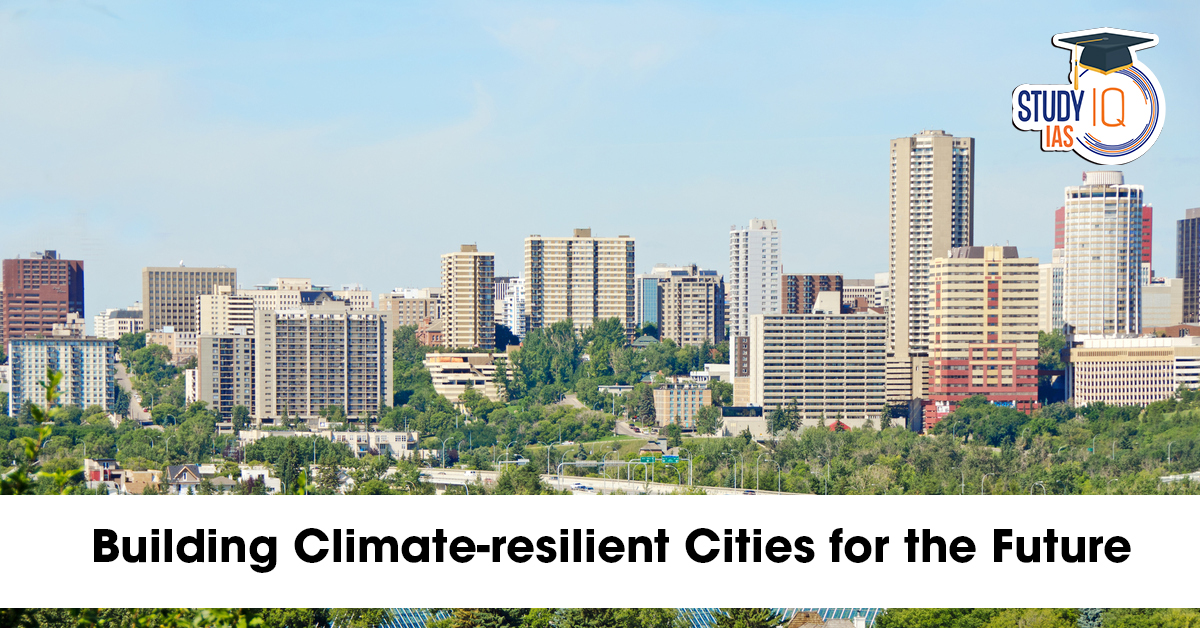Table of Contents
Context: Indian cities are set to play a decisive role in the country’s future. By 2050–2070, the urban population may reach 1 billion, with megacities larger than many countries. This rapid urbanisation creates both opportunities and risks.
| Urban Infrastructure Needs & Investment by 2070 |
|
Key Challenges Faced by Indian Cities
Climate Impacts and Hazards
- Flooding: Flooding is increasing due to poor drainage and rapid construction. By 2030, over two-thirds of urban dwellers will be at risk of surface/pluvial flooding.
- Estimated losses: $5 billion (2030) → $30 billion (2070).
- Extreme Heat: Urban heat island effect raises city temperatures 3–4°C above rural areas. With rising temperatures, the risk of heat-related deaths and productivity losses
- Heat-related deaths may double by 2050.
- Housing Vulnerability: Informal settlements often lie in low-lying, flood-prone areas with poor-quality housing. The current housing stock is highly vulnerable to floods, heat, cyclones, landslides, and earthquakes.
- Water Scarcity: Rising demand and climate stress create shortages, especially in slums with poor water access.
- Eg: Chennai’s “Day Zero” crisis (2019) when reservoirs ran dry.
Urban Development and Planning Gaps
- Rapid, Unplanned Urbanisation: Population will almost double by 2050, pushing growth into city fringes and high-risk zones.
- Inadequate Planning: Over 50% of towns lack approved master plans; existing plans are often poorly implemented.
- Loss of Green Cover: Low per capita green space worsens heat and reduces natural flood absorption.
- Transport Vulnerability: Even 10–20% road inundation can paralyse 50% of transport systems. Heat can warp rails and disrupt transport.
Rising Greenhouse Gas (GHG) Emissions
- Energy, Transport, Buildings: Horizontal, less-dense sprawl increases dependence on cars and energy demand.
- Solid Waste Management (SWM): Inefficient waste disposal produces methane (20% of global human-induced methane emissions). Blocked drains from waste worsen flooding.
- Housing Sector: Construction materials (cement, steel) and energy use in buildings add heavily to the carbon footprint.
Financing and Institutional Weaknesses
- Huge Investment Needs: Climate-resilient urban infrastructure requires $2.4 trillion by 2050 and $10.9 trillion by 2070.
- Low Revenue & Dependence: Municipalities rely heavily on central/state transfers; property tax collection is far below global norms.
- Limited Spending Capacity: Cities struggle to even use existing budgets due to weak capacity.
- Lack of Climate Finance Tracking: Climate-related spending isn’t tracked, making accountability and financing difficult.
- Low Private Sector Role: The Private sector contributes only 5% of urban infrastructure financing, deterred by policy and regulatory risks.
- Fragmented Governance: Overlapping roles across agencies cause delays and poor coordination.
- Limited Technical Expertise: Small/medium towns lack trained staff for risk assessment and climate planning.
| Urban Climate Resilience Initiatives |
Global Examples
|
Way Forward: Building Climate-Resilient and Low-Carbon Cities
City-Level Action Plans
- Risk Assessments: Regular climate risk studies, GHG inventories, and integration into land-use planning. Prevent construction in high-risk zones.
- Early Warning Systems: Multi-hazard warning systems with last-mile connectivity for vulnerable groups.
- Eg: Odisha’s cyclone warning system is credited with saving thousands of lives.
- Climate-Sensitive Development: Stronger building codes, resilient infrastructure, risk-sensitive zoning.
- Integrated Risk Reduction: Use both grey infrastructure (drainage, embankments) and green infrastructure (wetlands, parks, trees). Promote cool roofs, urban greening, and water-sensitive design.
- Focus on Vulnerable Populations: In-situ upgrades in slums, adaptive social protection, relocation as a last resort.
- Compact & Green City Planning: Encourage Transit-Oriented Development (TOD), mixed-use planning, and managed densification to reduce emissions.
- Municipal Services Upgrade: Waste-to-energy plants, recycling, and methane capture at landfills.
- Resilient Transport: Expand public transport, encourage walking/cycling, electrify buses, and build redundancy in road systems.
- Green Buildings: Solar rooftops, energy-efficient designs, incentives for low-income housing retrofits.
National and State-Level Resilience Programs
- Urban Resilience Missions: Launch national programs on flood resilience and heat management.
- Capacity Building: Train municipal staff, hire skilled urban planners and engineers.
- Data Systems: National hub for climate resilience data, GHG inventories, and project preparation.
- Integrated Policies: Align housing, waste, and transport policies with climate goals.
Financing and Institutional Reforms
- Increase Urban Investment: Raise the share of GDP for urban infrastructure, especially climate-related spending.
- Boost Municipal Revenues: Reform property tax, user fees, and service charges to raise own-source revenue.
- Climate Budget Tagging: Track climate-related spending in city accounts to improve transparency and attract funding.
- Innovative Financing: Use green bonds, carbon markets, land value capture, tax-increment financing, and international climate funds.
- Engage Private Sector: Create bankable projects, improve procurement, offer credit guarantees, and expand insurance markets.
Stakeholder Collaboration
- Multi-sector Planning: Integrate transport, housing, water, and waste management planning.
- Regional Cooperation: Address floods, waste, and pollution at river-basin and metropolitan levels, not just city boundaries.
- Citizen Participation: Engage communities in planning, waste segregation, water saving, and disaster response. Awareness campaigns for climate action.


 List of National Parks in India 2025, Ch...
List of National Parks in India 2025, Ch...
 Bonnet Macaques: Habitat, Features, Beha...
Bonnet Macaques: Habitat, Features, Beha...
 Periyar Tiger Reserve, Map, Flora, Fauna...
Periyar Tiger Reserve, Map, Flora, Fauna...

























